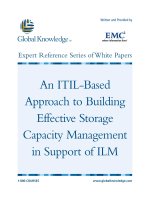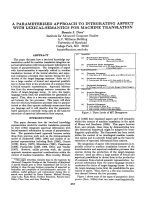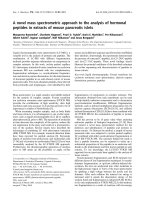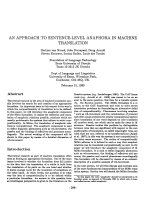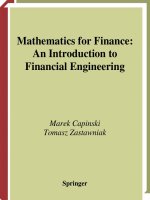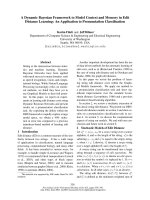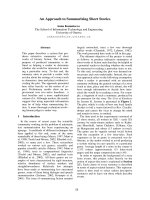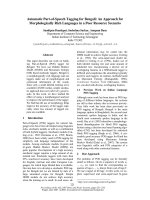Universal design for learning: An approach to support students with special needs in inclusive setting
Bạn đang xem bản rút gọn của tài liệu. Xem và tải ngay bản đầy đủ của tài liệu tại đây (198.86 KB, 8 trang )
HNUE JOURNAL OF SCIENCE
Educational Sciences, 2020, Volume 64, Issue 4B, pp. 137-144
This paper is available online at
UNIVERSAL DESIGN FOR LEARNING: AN APPROACH TO SUPPORT STUDENTS
WITH SPECIAL NEEDS IN INCLUSIVE SETTING
Tran Thi Bich Ngoc, Nguyen Ha My and Nguyen Minh Phuong
Faculty of Special Education, Hanoi National University of Education
Abstract. Universal Design for learning is a framework for instruction organized by three
principles based on the learning sciences. It helps teachers to create instructional goals,
methods, materials, environments, structures, and assessments without barriers that work for
all students. 8 indicators are given to help educators understand more about Universal design
for learning approach and some strategies are suggested for teachers and educational support
workers to use for students with special needs in Vietnam through multiple means of
engagement, multiple means of representation and multiple means of action and expression
to support them to learn in effectiveness.
Keywords: Universal Design for Learning, students with special needs, principles, strategies.
1.
Introduction
Universal Design for Learning (UDL) is a theoretical framework developed by the Center
for Applied Special Technology (CAST) to guide the development of curricula that are flexible
and supportive to all students within diverse contemporary classrooms. UDL improves and
optimizes teaching and learning for all people.[1]. UDL is derived from the concept of universal
design. The term “Universal Design” is in the Individuals with Disabilities Education Act (IDEA
2004) of the United Stated as “a concept or philosophy for designing and delivering products and
services that are usable by people with the widest possible range of functional capabilities, which
include products and services that are directly accessible (without requiring assistive
technologies) and products and services that are interoperable with assistive technologies.” [2].
The goal of UDL is to use an inclusive teaching methodology to remove barriers of learning
and give all students opportunities to engage in activities and access to all potential needs of
students. It is about building in flexibility that can be adjusted for every student’s strengths and
needs [3]. UDL framework challenges educators to consider how it can include options and varied
supports for all students. This is an important and transformative shift that helps teachers to design
and implement accessible, appropriate, and inclusive curriculum for every student [4]. The study
by Coyne et al. (2010) stated that UDL designed literacy instruction led to positive and relevant
learning outcomes for students with intellectual disability [5]. UDL is applied to instructional
activities for students with intellectual disability to examine a variety of interventions and
outcomes in educational settings and identifies important questions for consideration in future
research to determine how UDL can be applied to curriculum, used with evidence-based and
effective practices, and used to support school-wide initiatives inclusive of students with
intellectual disabilities [8].
Received April 11, 2020. Revised April 24, 2020. Accepted May 15, 2020.
Contact: Tran Thi Bich Ngoc, e-mail address:
137
Tran Thi Bich Ngoc, Nguyen Ha My and Nguyen Minh Phuong
Narkon and Wells (2013) mentioned in their article how instruction can be designed using
principles of UDL with story-mapping strategy to improve reading comprehension for students with
learning disability, which by boosting students’ accessibility to engagement and interaction [7].
However, barriers for implementing the UDL framework still exist when teachers and
educational support workers have been using this to meet the needs of students including the one
with special needs. Inclusive teacher and education support workers who need many in-depth preservice trainings about UDL and its principle, how to apply its principles to set goals and adjust
and accommodate curriculum, teaching methodology and educational environment to meet
students’ diverse demands [9]. A study about improved lesson planning with UDL stated that the
improved multiplicity of options in lesson planning demonstrates a better understanding of UDL
principles; however, teachers need more experience in implementing the UDL principles in their
classrooms to more effectively meet students’ individual needs [10]. Properly, educational
support workers who help teachers in doing some plans and work directly with students with
special needs in classroom could have some knowledge on how ULD process. It makes their
works more successful.
Besides, 14 groups of children including children with disabilities are regulated as
disadvantaged children accordance to Law on Children of Vietnam. More than 600,000 students
with disabilities going to general schoolswho lack some essential supports in learning are the
number estimated by MOET after 20 years implementing inclusive education. The inadequate
number of teachers have proficiency in special education, lack of teaching tools with traditional
teaching method, inflexible academic curriculum are barriers for students with disabilities to
thrive for knowledge. If we can find innovative ways to make curriculum accessible and
appropriate for individuals with different backgrounds, learning styles, abilities, and disabilities
in various learning situations and contexts, we can ensure the equal possibility in learning for all
of children. UDL principle show teachers and educational support worker how to be more flexible
in providing multiple ways of what children learn (presentation), why children learn (engagement)
and how children learn (expression what they have learned).
Hence, this article aimed to discuss about the roles of UDL in meeting the needs of all
students including the individuals with special needs and then provide some strategies to support
them in inclusive education in Vietnam.
2.
Content
2.1. Universal Design for Learning and its principles to ensure the needs of all students
The Center for Applied Special Technology (CAST) was established in 1984 in the North
Shore Children’s Hospital in Massachusetts with the aim of using technology to improve learning
for students with disabilities [11]. Then, CAST has become a leading authority to popularize the
principles of UD for education, through Universal Learning Design which provides a framework
to change the actual learning environment for every student. The three principles of ULD were
introduced in teaching process including using multiple means of representation, expression and
action and engagement [12].
The framework for instruction of ULD organized by three principles based on the learning
sciences, guiding the design and development of curriculum that is effective and inclusive for all
learners [13].
“Students are provided with scaffolds and supports to deeply understand and engage with
standards-based material. They not only have access to content and facts, but they learn to ask
questions, find information, and use that information effectively. They learn how to learn.” [2]
UDL provides new ways for teachers and educational support workers to customize their methods
138
Universal design for learning: an approach to support students with special needs in inclusive setting
to students with a range of abilities, interests, and backgrounds. Rose and Meyer (2006)
mentioned that all students even those who come from similar cultural backgrounds and have
similar abilities, can have different and unique ways to access learning tasks in order to understand
and master knowledge; therefore, UDL aims to adjust and reduce the limitations of a learning
environment rather than addressing students’ limitations [14].
Based on researching the learner differences and effective instructions, UDL principles
formulate a variety and flexibility in present or access information, concepts and idea (the what
of learning); plan and execute learning tasks (how of learning) and engagement in learning
process (the why of learning).
Representation: Representation provides various methods for learners to perceive
information represents the ‘what’ of learning to identify and categorize what we see, hear, and
read which offer information in many types of format such as textbooks, text, audio, video and
hands-on learning, etc. Multiple representations of meaning should be provided to ensure that
students could get the best opportunity to demonstrate their skills and knowledge [1]. Therefore,
applying multiple means of representation into curriculum support students with special needs
having significantly difficulty in accessing materials. For example, some students have struggles
when reading textbooks or understanding their teachers’ instruction; some other students cannot
control their behavior in their classrooms or have emotional disorders. Hence, teachers need to
adapt lesson plans for students with special needs so they can access content in different ways.
But UDL is much more than just presenting text digitally. Some students may grasp information
better through visual or auditory means rather than printed text. To accommodate these
differences, the UDL curriculum includes built-in options such as text, speech, video and audio
so that students can interact with the content using multiple senses, aligned to their individual
learning preferences.
Action and expression: Providing students multiple options for planning and performing
content-specific tasks, UDL gives students various ways to interact with the material and to show
what they’ve learned. With UDL, students can choose either take a pencil-and-paper test or g an
oral presentation or do a group project. Students differ in the ways that they can navigate a
learning environment and express what they know. Students with special needs may struggle with
strategic and organizational abilities, have language barriers, or emotional and behavior issues,
etc. and will demonstrate their mastery very differently. Multiple means of action and expression
provide different ways for students to demonstrate what they have learned such as multiple-choice
questions, short answers, matching things, group projects, or oral presentations, etc.
Engagement: UDL encourages teachers and educational support workers to look for
multiple ways to motivate students and engage students during lessons: Letting students make
choices and giving them assignments that feel relevant to students’ interest; or playing a game
and creating opportunities for students to move around the classroom.This principle is based on
the brain’s affective dimensions. Multiple means of engagement offer solutions to the problem so
often faced by students with special needs who lack of motivation to learn due to obstacles posed
by their difficulties in studying or skills. UDL allows teachers to alter the design based on the
student’s learning strengths and weaknesses while maintaining learning expectations. In order to
maintain levels of interest during the active-lecture, other strategies can sustain student
motivation, for example, delivering learning content by open discussion, Q&A sessions, peertutoring, and an applied problem-solving approach [15].
In summary, UDL approach ensure to provide accessible opportunities to qualified education
for all students regardless of ability, disability, gender, age, or background. Its principles help
teachers create instructional goals, methods, materials, environments, structures, and assessments
139
Tran Thi Bich Ngoc, Nguyen Ha My and Nguyen Minh Phuong
that work for all students and educational support workers find more ways to support students’
learning and engaging students in different ways.
2.2. Students with Special Educational Needs in Vietnam
“Special educational needs” is a legal definition and refers to children with learning problems
or disabilities that make it harder for them to learn than same age children. Students with special
educational needs may have problems with schoolwork, communication or behaviors. In
Vietnamese Law on Children 2016, there are 14 categories of disadvantaged children who has
many special education needs. The group of children with disability is ranked the fourth among
those kids.
All children have a right to access an appropriate and qualified education. The aim of
education is the same to all students including students with special educational needs that enable
them, in line with their abilities, to live their independent lives so that they can contribute to their
communities, cooperate with other people and continue to learn throughout their lives. Hence,
education is creating opportunities for all children to develop and growth in all aspects of their
lives – spiritual, moral, cognitive, emotional, imaginative, aesthetic, social and physical [16].
According to Action Aid International Vietnam (2014), 80% to 90% of the migrant workers
who move their children to new geographic regions must pay high tuition fees to attend semipublic or private schools for hardly to attend public school out of their hometown. Moreover, in
2016, MOET found migrant children non-attendance rate was 1.6 higher compared with nonmigrant children [17]. Social-economic status is a significant factor influencing a child’s
attendance in school. There is a marked difference between a child’s attendance rate between the
poorest and richest households, which is exacerbated by lower educational levels. At the age of
5, the children drop-out rate in the poorest household is 3 times as high as those from the richest
families. Similarly, dropout rates are equivalent 5.5 times higher for primary-aged children and
10 times higher for lower secondary-aged youth [18].
The 2011-2015 Education Sector Analysis found “more than half of the disabled children do
not attend classes”. From 2011-2015, the percentage of disabled students in school remained
relatively constant, 70% in primary education, about 28% in LSE and less than 1% in USE. While
there has been a slight increase in the number of disabled children in school, the government’s
target of enrolling 70% has gone unmet.
The General Statistics Office and UNICEF on 11 January 2019 announced the results of a
national survey of people with disabilities in Vietnam. This is the first large-scale survey using
international standards to collect comprehensive information on the lives of people with
disabilities in Vietnam, conducted by the General Statistics Office in 2016 and 2017 with
UNICEF technical assistance. According to the survey results, Vietnam has about 6.2 million
people with disabilities. About 13% of the population, nearly 12 million people live in households
with people with disabilities and this percentage is expected to increase [19].
The survey also found that children with disabilities had much lower chances of attending
school than children without disabilities especially in high school and higher education. By high
school, less than 1/3 of children with disabilities attend school at the right age, compared to 2/3
of children without disabilities.
Although a number of children with disabilities integrate into learning the same curriculum
has brought positive results, only 2% of primary and secondary schools are designed to be suitable
for students with disabilities and about 1/7 of the schools have a teacher trained in disability [19].
The Vietnam’s Education Development Strategy for 2015-2020 underscored the needs for
equitable access to education for children with special education needs. Inclusive education for
children with disabilities had officially shifted from being understood as a "humanitarian" activity
140
Universal design for learning: an approach to support students with special needs in inclusive setting
to show responsibility by the actions of individuals. In addition, the quality of education for
children with disabilities is improved, not only focusing on mobilizing numbers to access to
schools but also paying attention to the quality of learning [20].
However, lacking data on how many percentages of children with special educational needs
in inclusive schools and how to assess those special needs of an individual is a big question to
address. Depending on factors in the learning context, special educational needs of a child may
or may not be recognized. Consequently, children's special educational needs may not always be
sufficiently catered for. Several barriers are hampering the provision of adequate education to
students with special educational needs in mainstream schools.
Therefore, it is suggested that teachers and educational support workers should use a flexible
approach to recognize and accommodate and adjust the factual environment of classroom to fulfill
their students’ needs. ULD could be an appropriate framework for them to use.
2.3. How Universal Design for Learning can help students with special needs
All learners differ greatly in “what” they learn, how they learn and why they learn (Coyne et
al., 2006; Rose and Meyer, 2002) [21] [22]. All students are quite difference and have diverse
needs in learning such as learning style, pace of learning, or interests. Goal, method, material and
assessment must address the strengths and weaknesses of individual students to achieve their
highest potential.
Using a textbook with a lot of letter lead many students’ learning to a failure. Some students
with learning disabilities, students with intellectual disabilities and others may not learn by text
only. They need some more technologies and some applications to support sometimes such as
AAC, computers, text-to- speech software. Unfortunately, study materials that are not in
electronic formats, uncaptioned video, PDF files that do not contain any real text and therefore
cannot be searched or read aloud by text-to-speech software are often the same obstacles
encountered by students who have different learning styles. Through applying UDL, teachers
could have many choices to benefit those students by presenting materials in many ways. Hence
the “universal” in Universal Design for Learning includes the use of technology, how to present
knowledge in multiple modalities of instruction, how to assess the learning of students in flexible
ways, and group activities to give students choices and provide them opportunities to empower
themselves as learners.
New teachers or even though experienced teachers usually have one common concern on
how they can reach their students with special needs. Although most of them are received many
trainings to support for diverse students in inclusive school, many still feel that it is so challenging.
Within a framework providing three components or principles of engagement, presentation and
expression, teachers can provide multiple means of present materials, organize different activities
in a classroom to engage students involvement, assess what students learn in different ways.
Educational support workers supporting to teachers and directly students with special needs
should understand ULD principles to prepare some activities and maintain students’ engagement
in classroom, and support teachers to instruct lessons by multiple representations and multiple
ways of evaluation their achievement.
In general, ULD helps teachers and education support worker to be flexible to find the way
to remove barriers and fulfill their student’s potential in a diverse learning context.
2.4. Universal Design for Learning strategies to support students with special needs
in Vietnam
UDL can positively influence the level and experience of learning for students at various
levels of education. There are 8 performance indicators in UDL that can be helpful for all students
with special needs [23], as follow:
141
Tran Thi Bich Ngoc, Nguyen Ha My and Nguyen Minh Phuong
Friendly class climate: Students with special needs need a respectful and friendly school and
classroom to welcome them to involve. Some strategies can be used such as: Put a statement on
your syllabus inviting all students to discuss about their difficulties during studying and how to
support and accommodate to meet their special learning needs; form a circle of friend within
students with special needs so that those friend can support students with special needs in their
classroom and at home;
Interaction: Encourage and promote effective interactions between students and
teachers/educational support workers and communication methods should be accessible to all
participants. Some strategies such as: Assign group work so that students can support each other;
Physical environments: Facilities, activities, materials, and equipment are physically
accessible to and usable to all of students; it needs to guarantee the safety for students with special
needs. Some strategies such as: Develop safety procedures for students who are blind, deaf, or
wheelchair users;
Multiple instructional methods: Multiple instructional methods should be accessible to all
learners. Some strategies such as: Use multiple modes to deliver content; when possible allow
students to choose from multiple options for learning; peer-teaching, collaborative learning
groups, hands-on activities, Internet-based communications, educational software, field trip, and
so forth;
Information resources and technology: Ensure that materials, notes, and other information
resources are engaging, flexible, and accessible for all students. Some strategies such as: Use
printed materials and prepare a syllabus early to allow students to read materials and work on
assignments before a subject; use-books with pictures for students with intellectual disabilities or
autism or audio books for students with visual impairments;
Feedback: Teachers should provide specific feedback to students. Some strategies such as
reward students with special needs when they finish their tasks; timely prompt for students to
finish their tasks;
Assessment: Teachers should regularly assess student progress by using multiple accessible
methods and tools and adjust instruction accordingly. Some strategies such as assess group work
and cooperative performance, evaluate an individual achievement following their progress and
their strengths;
Accommodation: Teachers should have a plan for accommodation whenever students’ needs
are not met by the instructional design. Some strategies such as: rescheduling classroom locations
and arrange physical environment appropriate for student with special needs as students with
visual impairment should have a seat closely to teachers to hear teachers’ voice.
For students with special needs in Vietnam, which are also named as disadvantaged children,
the most vulnerable group is a group of children with disabilities who has a little support at general
school. Teachers could use ULD to meet their needs and demands for learning and here are some
suggested strategies based on ULD principles for teachers and educators to work with those
students:
Multiple means of representation: Comprehensive print and electronic syllabus for each
subject requirement and expectation should be given. For students who have difficulties in
learning, the way of instruction is very important to them so that teachers should include and use
examples or illustrations by real object or using teaching tools. In order to introduce a new
concept, teachers could highlight and introduce again and again. The content of subject should be
presented by using visual, auditory, graphic, and verbal formats. Using electronic devices such as
e-book or caption video or AAC is a good idea for teachers to work with students with autism,
intellectual disabilities in classroom. Cooperative group activities should be use more in each
142
Universal design for learning: an approach to support students with special needs in inclusive setting
class. Educational support workers can help teachers to prepare those teaching tools and support
students when they use those technologies in classroom.
Multiple means of action and expression: Teachers can create class activities or games.
By the way students can be easily to remember lessons through a hand-on activity or an interesting
game. Providing examples of learning strategies for student to attain, encourage them to share
their thoughts and feeling about the lessons and the world around us. The requirement here is that
students can have their opportunities to express what they have learned in multiple ways such as
assignment, project, writing test, presentation, image and pictures, paintings, computer-based test,
blogs through individual or group works. Let students conduct presentations or their learning.
Teachers should offer ongoing feedbacks for each student. Educational support worker help
students with special needs to perform the game in case they need or express what they have
learned in various ways and give more feedback for their action and achievement.
Multiple means of engagement: How to have attraction by all students in classroom and
maintain their engagement in the whole lesson is a big question for any teacher. Some ways to
get involvement from students with special needs are: Eliminating all distractions; for example,
we need to remove detail objects or picture annoyed students with autism in their classroom[24];
Using multimedia technology such as I-pad and computer is an essential tool for
teachers/educational support workers to teach or organize an activity in the classroom;
Encouraging collaboration in classroom within some group works or set up an cooperative group
learning climate; Using their interests to teach; Giving them a choice; Providing opportunities for
whole group discussions, and fostering communication with all students. Educational support
workers should accompany to teachers to provide multiple means of engagement for students with
special needs such as discussing about students’ interests to teachers, helping students to involve
in a group work and whole class discussion, mobilizing other students to join in activities with
special needs students.
3.
Conclusion and recommendations
The traditional teaching approach and strategies cannot meet the diversity of students in
current situation. Meanwhile, ULD is a framework with 3 principles and can be applied to all
students in general and students with special needs. Providing multiple means of presentation,
expression and action and engagement help students with special needs access to curriculum and
achieve their highest potential. UDL also helps educators to view students’ diversity as a chance
for enhancing the educational system rather than as a barrier to their engagement and achievement
at schools. Although teachers and educational support workers are continually challenged by the
differences among their students, resources, reforms, and practices continue to progress, active
methods and strategies that provided in this article might help them to meet the needs of their
students. UDL should be studied more on how to apply to each category of children with special
needs in the context of Vietnam.
REFERENCES
[1] Dolan, R. P., & Hall, T. E., 2001. Universal Design for Learning: Implications for Largescale Assessment. IDA Perspectives, 27(4), 22-25.
[2] CAST. UDL Toolkits: Planning for All Learners (PAL). (n.d.). Retrieved August 19, 2003,
from />[3] Capp, M. J., 2017. The Effectiveness of Universal Design for Learning: A Meta-analysis of
Literature between 2013 and 2016. International Journal of Inclusive Education, Volume 21,
2017, Issue 8, 791-807.
143
Tran Thi Bich Ngoc, Nguyen Ha My and Nguyen Minh Phuong
[4] Pisha, B., & Coyne, P., 2001. Smart from the start: The promise of universal design for
learning. Remedial and Special Education, 22(4), 197.
[5] Coyne, P., Pisha, B., Dalton, B., Zeph, L., & Smith, N. C., 2010. Literacy by design: A
universal design for learning approach for students with significant intellectual disabilities.
Remedial and Special Education, 33, 162-172.
[6] Wehmeyer, Michael., 2006. Universal Design for Learning, Access to the General Education
Curriculum and Students with Mild Mental Retardation. Exceptionality. 14. 225-235.
[7] Narkon, D. E., Wells, J. C., 2013), Improving Reading Comprehension for Elementary
Students with Learning Disabilities: UDL Enhanced Story Mapping, Preventing School
Failure, Alternative Education for Children and Youth, 57:4, 231-239
[8] Rao, K., Smith, S. J., & Lowrey K. A., 2017), UDL and Intellectual Disability: What Do We
Know and Where Do We Go? Intellectual and Developmental Disabilities: February 2017,
Vol. 55, No. 1, pp. 37-47.
[9] Scott, L. A., 2018. Barriers with Implementing a Universal Design for Learning Framework.
6. pp. 274-286.
[10] Courey, S. J., Tappe, P., Siker, J., & LePage, P., 2013. Improved Lesson Planning with
Universal Design for Learning (UDL). SAGE journals, Volume: 36 issue: 1, 7-27
[11] CAST, 2011. Universal Design for Learning Guidelines version 2.0. Wakefield, MA: Author.
[12] Matthew T. Marino, Maya Israel, Constance C. Beecher, James D. Basham, 2013. Students'
and Teachers' Perceptions of Using Video Games to Enhance Science Instruction, Springer
Publication.
[13] Rose, D.H. & Gravel, J.W., 2010. Universal design for learning. In E. Baker, P. Peterson, &
B. McGaw (Eds.). International Encyclopedia of Education, 3rd Ed. Oxford: Elsevier.
[14] Rose, D. H., & Meyer, A., 2006. A practical reader in universal design for learning Harvard
Education Press.
[15] Al-Azawei, A., Serenelli, F., &Lundqvist, K., 2016. Universal Design for Learning (UDL):
A Content Analysis of Peer Reviewed,a Journal Papers from 2012 to 2015.Journal of the
Scholarship of Teaching and Learning, Vol. 16, No. 3
[16] National Council for Special Education, 2014. Children with Special Needs, Information
Booklet for Parents.
[17] World Bank – Ministry of Planning and Investment, 2015), The Vietnam 2035 Report
[18] Action Aid International Vietnam, 2016. Female and Internal Migration: An Arduous
Journey for Opportunities.
[19] UNICEF, 2019. Launch of Key Findings of Vietnam’s first large-scale National Survey on
People with Disabilities. Retrieved from />[20] Nguyen Xuan Hai, 2010. Inclusive Education Managerment, Publisher of Hanoi University
of Education.
[21] Coyne et al., 2006. Giving Children a Voice: Investigation of Children’s Experiences of
Participation in Consultation and Decision-Making in Irish Hospitals, Office of the Minister
for Children.
[22] Rose, D. H., & Meyer, A., 2002. Teaching every student in the digital age: Universal Design
for Learning. Retrieved July 12, 2007, from the Association for Supervision and Curriculum
Development />[23] Sheryl Burgstahler,, 2007. Universal design in education: Principles and application, DOIT, University of Washington.
[24] Tran Thi Bich Ngoc, Pham Thi Hai Yen, 2016. Designing universal teaching plan for
children with autism spectrum disorders in inclusive schools, Journal of Education.
144

